Table of contents:
Are you figuring out where your Zoom recordings go?
With more individuals and companies relying on Zoom each day, it’s essential to understand how Zoom works to use it to its fullest potential. We get it. Understanding the difference between Zoom’s cloud and local recordings can be confusing. Next thing you know, you’re not sure where to find your recording files.
In this article, we’ll help you by exploring where Zoom saves meeting recordings and how you can find them.
Where do Zoom recordings go?
Zoom recordings go to one of two places: the Zoom Cloud or the meeting host’s computer.
Below we’ll explain what that means and the pros and cons of each.
Zoom Cloud Recordings
The Zoom Cloud is just a fancy name for Zoom’s online servers. When you record a Zoom meeting to the cloud, Zoom’s servers store the recording online instead of directly on your computer. If you’re in the U.S., they’ll be in your account on Zoom.us.
There are both pros and cons to using Zoom cloud recording.
Pros
- Saves storage space on your computer
- Easy to share recordings with others
Cons
- Requires Pro, Business, or Enterprise subscription with Cloud Recording add-on plan
- Limited storage capacity unless you upgrade to Enterprise
You can also opt to record Zoom meetings locally.
Zoom Local Recordings
Zoom local recordings are Zoom meeting recordings stored directly (locally) in your computer’s documents folder.
An easy way to understand the difference between Zoom cloud recordings and local recordings is to compare them to storing a file in Google Drive versus in your computer’s Documents folder. One is stored on the internet; one is not.
There are also pros and cons to this method.
Pros
- You won’t have to pay for extra cloud storage
- Some companies prohibit storing Zoom recordings in the cloud for security reasons.
Cons
- Video files take up a lot of hard drive space, which can cause your computer to run more slowly
- Difficult to share large files
Since many people use both cloud and local recordings, we’ll tell you exactly where Zoom stores each type and how to get to them.
How to find Zoom Cloud Recordings
The easiest way to find a Zoom Cloud recording is to check your email. Once a recording has finished uploading, Zoom will send you an email with a direct link to the recording. The message will come to the email associated with your Zoom account.
But what if you want to watch or share an older cloud recording?
Finding a Zoom cloud recording on your online account
Here’s how you can go straight to your Zoom Cloud to see a list of all of your recordings.
Step 1: Go to Zoom.us and log in to your account.
Step 2: On the left vertical menu bar, click Recordings.
Step 3: Click Cloud Recordings to see a list of your recordings.
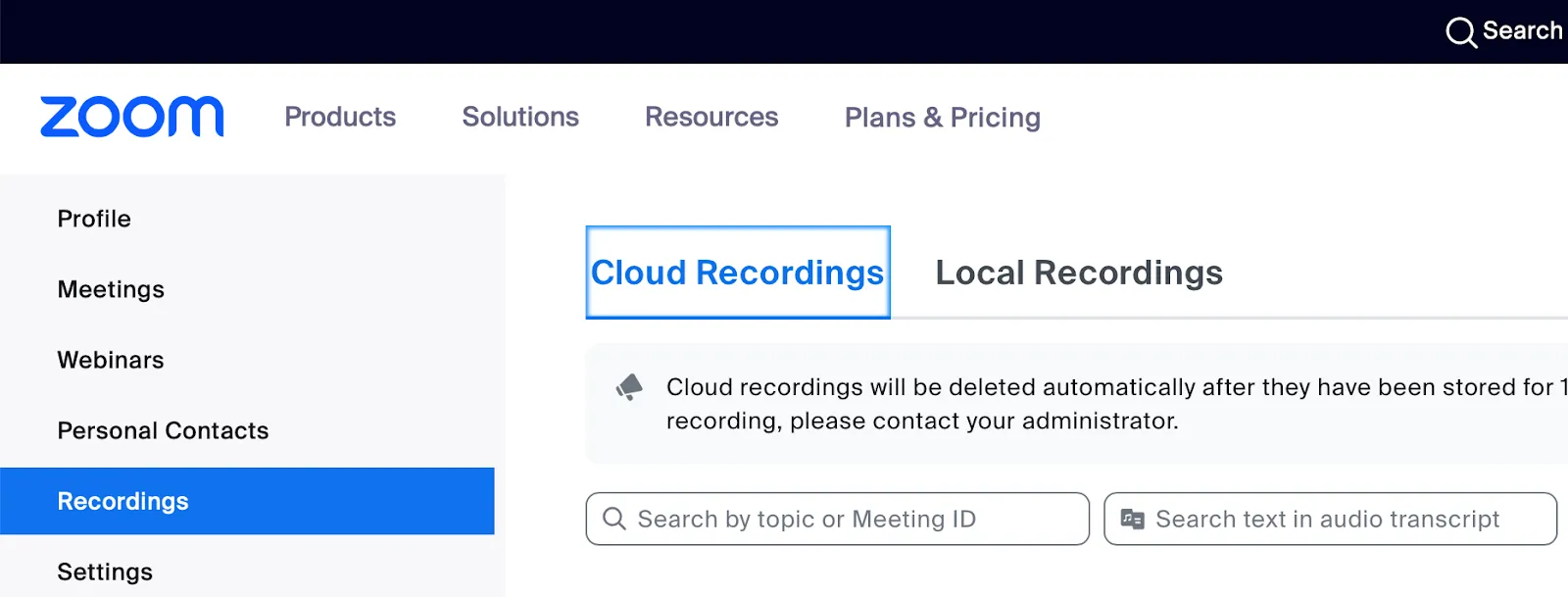
Note that many companies automatically set Zoom to delete recordings after a certain number of days. So if you’re looking for an older recording on your company Zoom account, it may no longer be there.
Finding a Zoom cloud recording on your desktop app
You can also access your Zoom Cloud indirectly through your Zoom desktop app.
Here’s how to do that.
Step 1: Open the Zoom app on your computer.
Step 2: Click Meetings on the top horizontal menu.
Step 3: Click Recorded on the left.

Step 4: You’ll see a list of all your recordings—cloud and local. Click on a recording. If you see View, it’s a cloud recording. If you see Open, it’s a local recording.
Step 5: Find your desired cloud recording, then click View. This will take you to the recording in the Zoom Cloud, where you can watch or share it.
Finding cloud recordings as an account administrator
If you’re a Zoom account administrator, the steps to view recordings are a little different.
Step 1: Go to Zoom.us and log in to your account.
Step 2: Click on Account Management.
Step 3: Click on Recording Management.
Step 4: You’ll see a list of recordings. Click on the one you want to watch or share.
Pro tip: Zoom recordings upload to the meeting host’s Zoom account. That’s true even if a co-host or participant starts the recording and even if you, the host, aren’t in the meeting. So if you need to join late, rest assured that your recording will be right there in your Zoom account when you need it.
How to find Zoom Local Recordings
There are three ways to find Zoom local recordings: using the Zoom desktop app, going straight to the recording yourself, or using your online Zoom account.
Finding Zoom local recordings using the Zoom app
Your Zoom desktop app is responsible for managing local recordings. By default, it saves them in a Zoom folder under the Documents folder on the C drive of the computer that recorded the meeting. And it can take you right to them. Here’s how.
Step 1: Open the Zoom app on your computer.
Step 2: Click Meetings on the top horizontal menu.
Step 3: Click Recorded on the left.
Step 4: Find your desired local recording and click Open.
When you click on a local recording in the Zoom app, you’ll notice the File Location written out above the View button. That’s the app showing you exactly where on your computer the recording is stored. Pretty cool, huh?
Going directly to the recording
If you’d like to go directly to a locally recorded file on your computer instead of going through the Zoom app, here are the steps to follow.
On a Mac:
Step 1: Click on Finder in the bottom left corner of your screen.
Step 2: Click Documents in the vertical menu on the left.
Step 3: Click Search at the top right, and type “Zoom” into the search box.
Step 4: You should see a folder labeled “Zoom”. Click on it.
Step 5: Unless you’ve adjusted your storage settings, this is where you’ll find a list of your local recordings, organized by date and title. Simply click on the one you want.
On a Windows PC:
Step 1: Click Start in the bottom left corner of your screen.
Step 2: Click the Documents icon in the vertical menu bar on the left.
Step 3: In the Search bar at the top right, type “Zoom.”
Step 4: Click on the Zoom folder that appears, then choose the recording you want.
Finding local recordings using your online account
Lastly, just as the Zoom desktop app can take you to a cloud recording, your online account can take you to a local recording as long as you’ve kept up with your Zoom updates. To see your local recordings in the Zoom Cloud, you’ll need Zoom version 4.0.25513.0228 or higher.
Here’s how to do it.
Step 1: Go to Zoom.us and log in to your account.
Step 2: On the left vertical menu bar, click Recordings.
Step 3: Click Local Recordings. Here you can see the file path to the recording on your computer, but no need to find the recording on your own; clicking Open will take you to it.
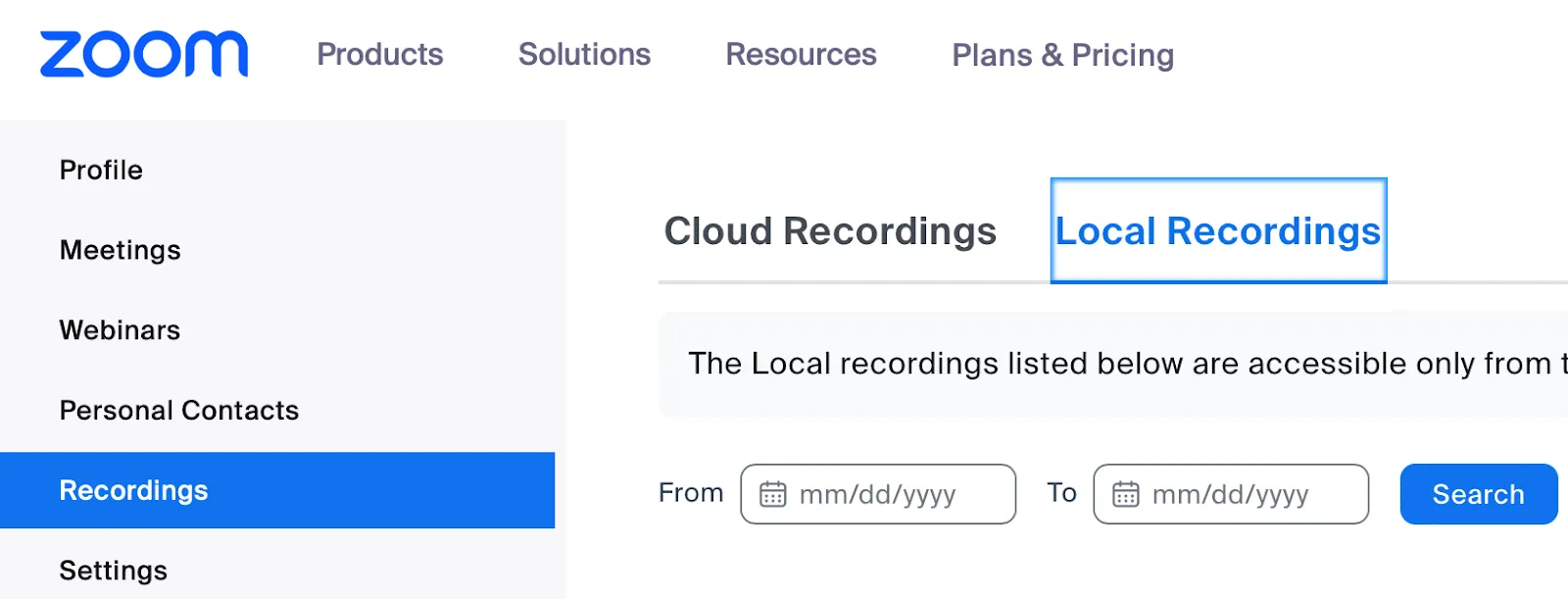
For a step-by-step guide, check out our article on how to record videos locally on Zoom.
Where do Zoom recordings go on your phone (iOS & Android)
When you record a Zoom meeting on your phone, it goes straight to the Zoom Cloud. Local Zoom recording is not currently possible on a mobile device, so phone recordings are always cloud recordings.
Remember that without a Pro, Business, or Enterprise subscription and the Cloud Recording add-on plan, you cannot record to the cloud. That means you can join or host a Zoom meeting on a phone, but you cannot record it.
For those who have the right subscription, here’s how to find a phone Zoom meeting recording. These steps are the same on any device with internet access—computer, phone, iPad, Tablet, etc.
Step 1: Go to Zoom.us and log in to your account.
Step 2: On the left vertical menu bar, click Recordings.
Step 3: Click Cloud Recordings to see a list of your recordings.
Since phone recordings are never stored locally, you cannot find the recording in the Zoom app on your phone. You’ll need to go to the website above.
How to change where Zoom recordings go
Change where all recordings are stored
First, you can set all of your Zoom meetings to record automatically either to the Cloud or locally. Here’s how to do that.
Step 1: Log in to your account on Zoom.us.
Step 2: On the left vertical menu bar, click Settings.
Step 3: Click Recording.
Step 4: Scroll down to Automatic Recording and toggle it on.

Step 5: Select either Record on the local computer or Record in the cloud.
Change where individual recordings go
If you don’t want to record every meeting, you can set individual meetings to record automatically. You can do this by following the usual steps to schedule a meeting from your online account or the desktop Zoom app.
If you’re scheduling a meeting from the desktop app:
Step 1: Under the Home tab, click Schedule.
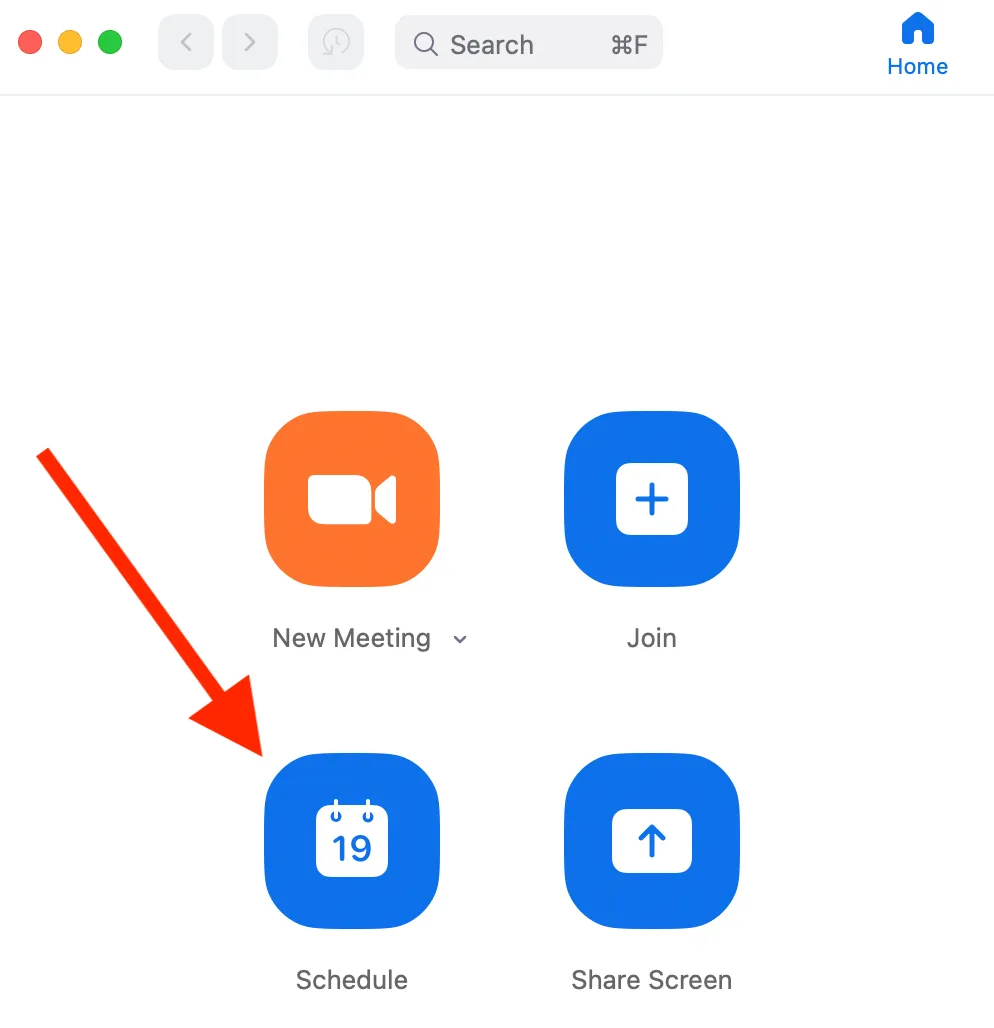
Step 2: Click the arrow beside Advanced Options and check the box beside Automatically record meeting.
Step 3: Choose Locally or In the cloud.

If you’re scheduling a meeting from your online account:
Step 1: Under the Meetings tab, click Schedule a Meeting.

Step 2: Scroll down to Options and click Show.
Step 3: Check the box beside Automatically record meeting and choose your desired location.

You can also choose where a Zoom recording will go directly from an active Zoom meeting. When you click Record during a meeting, Zoom will prompt you to choose Record on this computer or Record to the cloud.
Change where local recordings go
Lastly, you can choose where local recordings go on your computer. To do that:
Step 1: From the Zoom desktop app, click on your profile picture (or initials) in the top right corner.
Step 2: Click Settings.
Step 3: Click Recording.
Step 4: You’ll see a box at the top of the screen that says “Store my recordings at:” and contains a file path. Click anywhere inside the box.
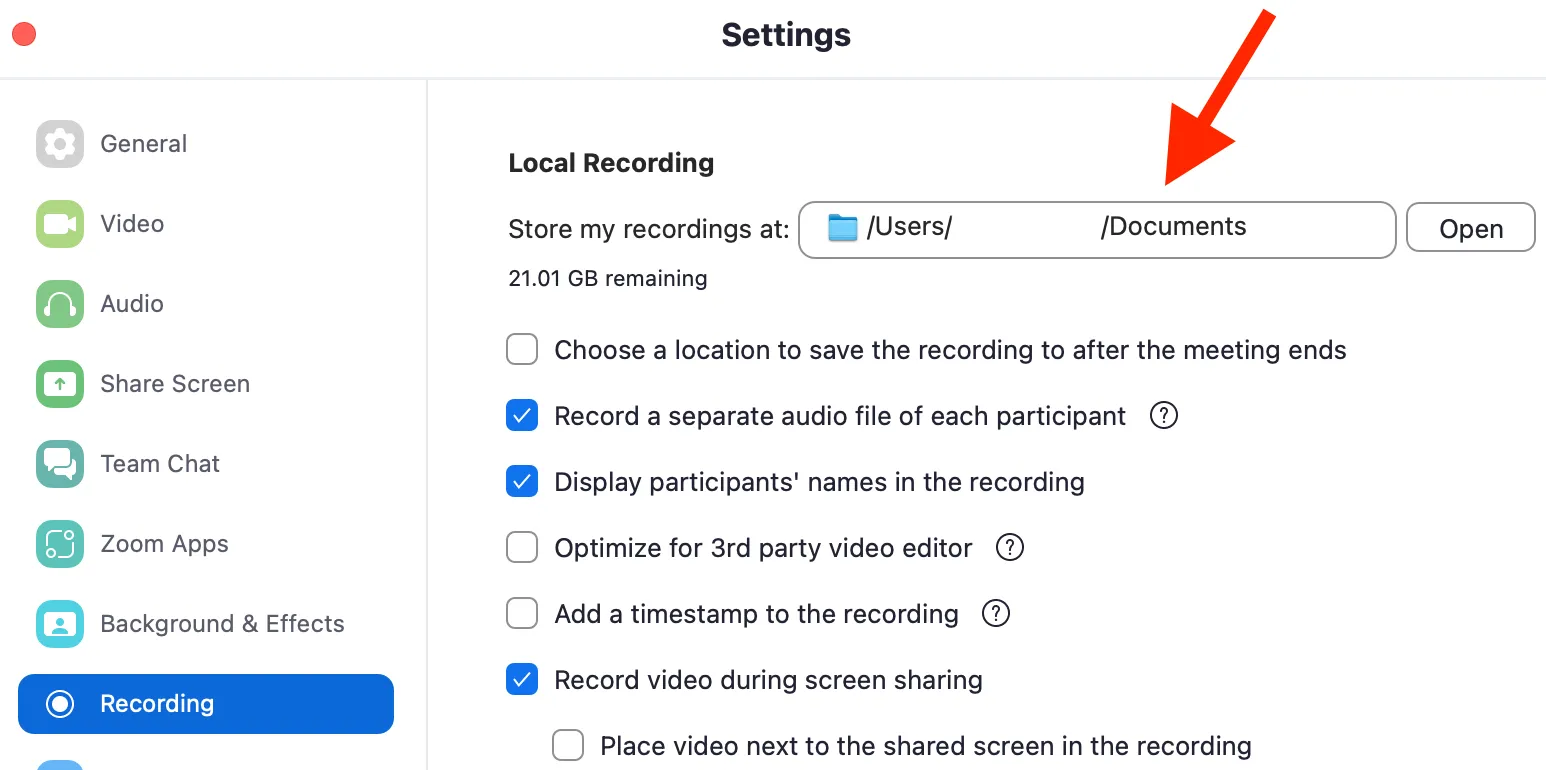
Step 5: Click Choose a new location. This will open a menu with your computer folders. Just click the folder you want to house your local Zoom recordings.
Zoom Cloud vs Local Recordings: Which should you choose?
Whether Zoom cloud or local recordings are best for you depends on a few factors.
If you’re on a budget, go with local recording. Zoom requires a paid subscription to record to the cloud. Do note that you can’t record locally on a phone, so if you need to record a Zoom meeting on your phone, you’ll have to pay for a subscription.
Local recording may also be best if you’ll be recording work meetings. Many companies don’t want you to record meetings to the cloud for security reasons.
On the other hand, if you have the money for a subscription, are recording non-sensitive meetings, and want to save space on your computer, go with cloud recording.
Zoom Cloud vs Local Recording Quality
You won’t see a big difference in recording quality between Zoom’s cloud and local recording. Zoom captures both over the internet, so if you have a poor internet connection, you may end up with audio or video lag in your recording.
You can avoid that by using online meeting software that simply records directly through your device instead of over the internet. Think of this like capturing a video of yourself using your computer’s native recording app (QuickTime for Mac and Game Bar for Windows). Your computer is doing the recording—the internet is not involved. In a similar way, some software can use your computer to record a meeting taking place over the internet.
“Riverside is far better than Zoom for recording interviews.” - Seth Godin, author, entrepreneur and marketing leader.
The best software for that is Riverside.
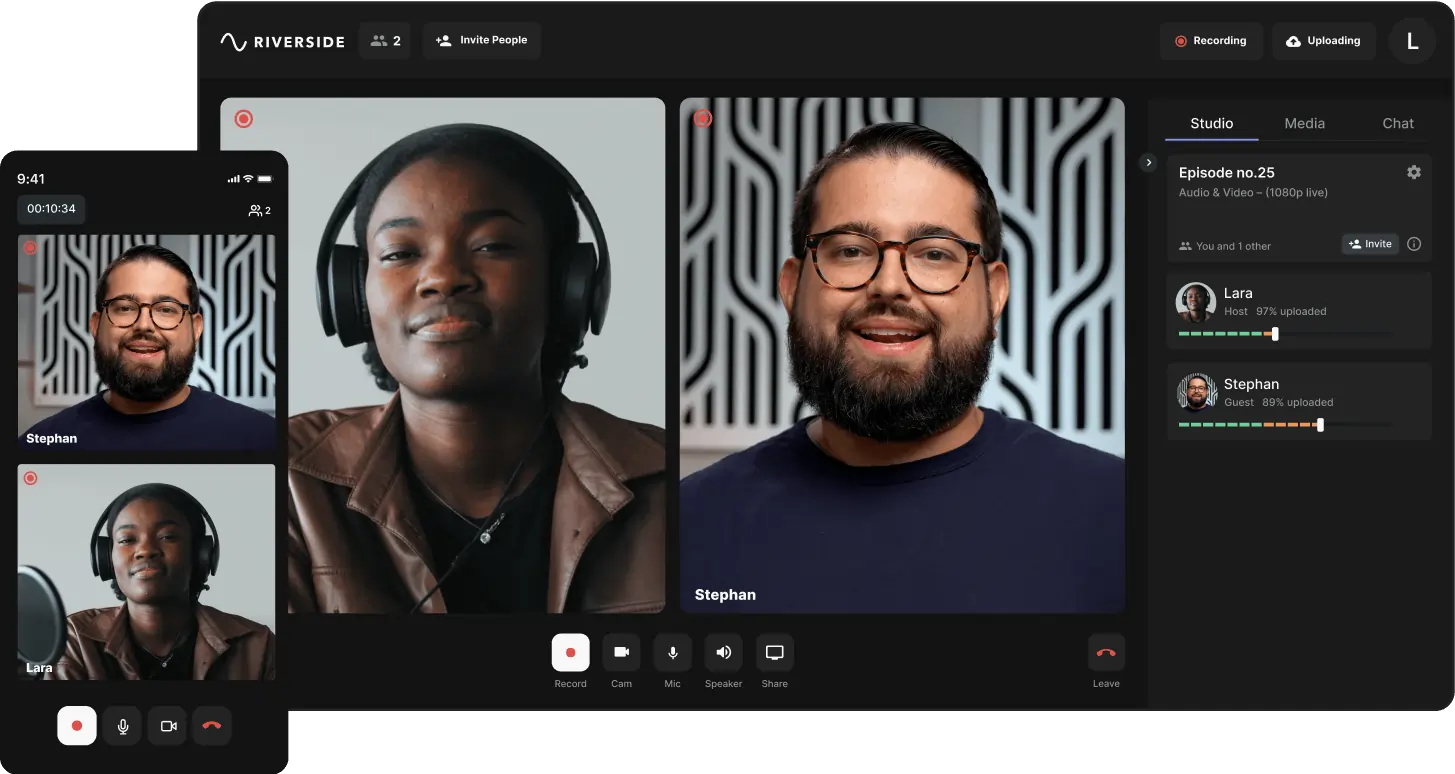
Riverside uses your computer to record videos and stores them online, where sharing them with others is easy. Conversely, Zoom uses the internet to record videos and, unless you pay for a subscription, stores them on your computer where they take up space, and it’s difficult to share them with others.
Both Riverside and Zoom refer to this as local recording. But for Zoom, it’s actually local storing; for Riverside, it’s true local recording.
And the best part? Local recording with Riverside is completely free.
Here are a few more reasons we recommend Riverside over Zoom for high-quality meeting recordings:
1. Zoom compresses audio (removes parts of the track) to increase connection speed during meetings. That can make recordings sound distorted.
Riverside offers either uncompressed audio or lossless compressed audio, which increases connection speed while maintaining audio quality.
2. Unless you pay for a subscription, Zoom records in 360p video resolution. You get 720p resolution with a subscription, but only for 2-person meetings. 1080p resolution requires a Business or Enterprise subscription, which starts at $199.90/month.
Riverside records up to 8-person meetings in up to 720p resolution without a subscription and in up to 4K resolution for a $15/month subscription.
3. You cannot record locally using Zoom on your phone. With Riverside’s mobile app for iOS or Android, you can record locally in up to 720p resolution for free.
4. Riverside has a text-based video editor that makes it easy for anyone to turn their recordings into professional content.
To try it for yourself, just go to Riverside.fm and click Get Started to set up your free account and record your first meeting.
FAQs on Where Zoom Recordings Go
How do I find recorded Zoom meetings?
You can find recorded Zoom meetings by opening your desktop Zoom app, choosing Meetings from the menu bar at the top, and clicking Recorded.
You can also access your recordings by going to Zoom.us, signing in to your Zoom account, and choosing Recordings from the menu on the left.
Why can't I find my recorded Zoom meeting?
There are several reasons why you may be having trouble finding your recorded Zoom meeting.
- You have more than one Zoom account and you’re logged in to the wrong one.
- You’re on the wrong computer. Local recordings are stored on the computer that recorded the meeting.
- You weren’t the host of the recorded Zoom meeting.
- You didn’t renew your Zoom subscription. The cloud recordings you made with a subscription will not be available with a free account.
- You’re looking in the wrong folder on your computer. By default, local recordings are saved in your Documents folder.
- Your Zoom account administrator has set recordings to auto-delete after a certain number of days, and your recording has been deleted.
Be sure you’re subscribed and logged in, or contact your account admin.
Where do Zoom recordings go on my phone?
When you record a Zoom meeting on your phone, it’s uploaded to the Zoom Cloud. Log in to your account at Zoom.us to access it. You won’t find the recording on your phone.
How can I record Zoom meetings?
You can record Zoom meetings by clicking Record from an active meeting. You can also set all meetings or an individual meeting to auto-record ahead of time through the Zoom app or your online Zoom account.
Check out our recent article for a step-by-step guide to recording Zoom meetings.
But if you’re looking for a Zoom alternative that captures higher-quality recordings and takes up less space in your Documents folder, check out Riverside. Once you try it, there’ll be no going back. Don’t believe us? See for yourself.















.webp)



